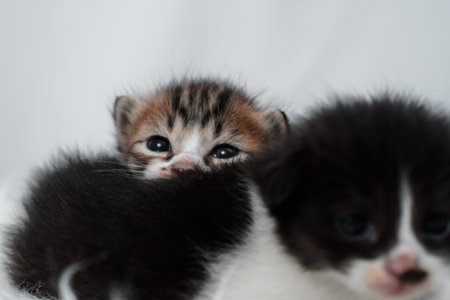1. Introduction: The Great British Debate
From the winding cobbled lanes of York to the windswept coasts of Cornwall and up through the misty Scottish Highlands, there’s a spirited discussion brewing in homes across the UK: what’s truly best for our beloved moggies — raw or commercial cat food? As proud pet parents, we’re seeing a remarkable rise in both traditional commercial options (think those familiar tins and kibbles from your local Sainsbury’s) and the increasingly trendy raw diets that promise a more “natural” feast for our feline companions. This shift isn’t just about spoiling our cats (though let’s be honest, that’s part of it!); it’s driven by a growing desire among British cat owners to ensure our pets live long, healthy, adventure-filled lives. Whether you’re strolling along Brighton Pier with your curious tabby or snuggling by the Aga in a Cotswold cottage with your purring pal, understanding this debate matters — because what we choose to put in their bowls could make all the difference from kittenhood to their golden years.
Raw Cat Food: Embracing the Wild Instincts
Raw feeding, often described as “going back to feline roots,” has taken off among British cat lovers who want their moggies to experience the diet of their wild ancestors. Unlike shop-bought kibble or tinned food, raw diets usually feature uncooked meats, bones, and organs—sometimes with a sprinkle of veg or supplements for extra nutrition. The idea is to mirror what a wildcat might hunt in the British countryside, from rabbits to birds.
How British Owners Are Prepping Raw Meals
Across the UK, some owners prefer DIY approaches, visiting local butchers or farmers’ markets to source fresh chicken wings, beef hearts, or even rabbit. Others opt for ready-made raw food mixes from boutique pet shops or specialist online retailers—many of which guarantee ethically sourced British meat. Here’s a look at common sourcing methods:
| Sourcing Method | Description |
|---|---|
| DIY Prep | Buying raw cuts from local butchers or supermarkets and preparing meals at home. |
| Ready-Made Raw Mixes | Purchasing pre-portioned raw meals from pet stores or online suppliers. |
Why Go Raw? Benefits for British Moggies
Advocates of raw feeding claim several perks for our furry companions. Many report shinier coats, healthier gums and teeth, improved digestion, and heaps more energy—just what an adventurous British moggy needs for garden prowls and sofa sprints alike. For cats who seem bored with bland biscuits, a taste of “the wild” might reignite their natural instincts and zest for life.
Potential Benefits Table
| Benefit | Description |
|---|---|
| Improved Digestion | Some cats have fewer tummy troubles on a grain-free, raw diet. |
| Dental Health | Chewing raw meaty bones can help keep teeth clean naturally. |
| Increased Energy | Cats may become more playful and alert after switching diets. |
A Nod to British Countryside Instincts
The appeal of raw feeding in the UK isn’t just about nutrition—it’s also about connecting indoor cats with their rural heritage. Whether your tabby dreams of chasing voles across Cornish fields or simply enjoys a whiff of gamey chicken in your London flat, raw diets offer a taste of adventure right in the heart of Britain’s homes.

3. Commercial Cat Food: Convenience on the High Street
If you’ve ever wandered through a British supermarket or popped into your local pet shop, you’ll know just how impressive the range of commercial cat food options is. From the heart of London to the peaceful lanes of the Lake District, shelves are lined with tins, pouches, and bags offering everything from gourmet salmon pâté to crunchy chicken biscuits.
The Appeal for Urban and Rural Cat Owners
For busy Londoners juggling work commutes and city adventures with their feline companions, convenience is king. Commercial cat foods—whether wet or dry—are readily available at Tesco, Sainsbury’s, Pets at Home, or even the village Co-op. No need to fuss over raw diets or special storage; just grab a tin or scoop some kibble into your cat’s bowl before dashing out to catch the Tube.
Meanwhile, country dwellers appreciate these options too. With unpredictable British weather and long countryside walks with your tabby in tow, it’s comforting to have a stash of food that stores well and meets all your moggie’s nutritional needs without extra effort.
Types of Commercial Cat Food Available Across the UK
| Type | Format | Main Benefits |
|---|---|---|
| Wet Food | Tins & Pouches | Hydration support, variety of flavours, easy for fussy eaters |
| Dry Food | Bags & Boxes | Convenient storage, dental health support, cost-effective for multi-cat households |
| Special Diets | Tins, Pouches & Bags | Supports allergies, weight management, senior cats’ needs |
Why Brits Choose Commercial Cat Food
The charm lies in its simplicity: no prep time, clear feeding guidelines (usually printed right on the packet), and the reassurance that every meal is nutritionally balanced according to UK pet food standards. Whether you’re dashing between meetings in Canary Wharf or setting off for a weekend hike in Snowdonia with your adventurous kitty, commercial cat food fits seamlessly into our uniquely British lifestyles.
4. Nutritional Considerations for British Cats
When choosing between raw and commercial cat food, British pet parents must weigh up the nutritional benefits and drawbacks of each option, taking into account guidance from UK vets and respected organisations such as the RSPCA. Here’s a closer look at how each diet stacks up nutritionally.
Raw Cat Food
Supporters of raw diets argue that they more closely mimic what cats would eat in the wild—think rabbits, birds, or mice across the British countryside. A raw diet can offer high protein content and may be less processed, which appeals to some owners seeking a natural approach. However, feeding raw comes with its own challenges:
- Nutrient Imbalance: Home-prepared raw meals can lack essential vitamins and minerals if not carefully planned, leading to deficiencies or excesses.
- Bacterial Risks: Raw meats can harbour bacteria like Salmonella or E. coli, posing health risks to both your cat and your household.
- UK Vet Guidance: Most UK vets and the RSPCA advise caution with raw diets due to potential safety concerns unless supervised by a feline nutritionist.
Commercial Cat Food
Commercial cat foods available in Britain are strictly regulated and designed to meet the complete dietary needs of cats, following standards set by FEDIAF (the European Pet Food Industry Federation) and endorsed by local animal welfare groups.
- Balanced Nutrition: Commercial foods typically provide all required nutrients in appropriate amounts for every life stage—from playful kittens in Liverpool to senior moggies in London flats.
- Convenience & Safety: These products are tested for pathogens and fortified with taurine, vitamins, and minerals essential for feline health.
- Additives & Fillers: Some commercial brands use fillers or artificial ingredients, so it’s wise to read labels or consult your vet for recommendations suited to British cats’ needs.
Nutritional Comparison Table
| Nutritional Aspect | Raw Diet | Commercial Diet |
|---|---|---|
| Protein Quality | Generally high (if meat is fresh) | Adequate; varies by brand/quality |
| Taurine Content | Risk of deficiency unless supplemented | Sufficiently added per regulations |
| Bacteria Risk | Higher (unless handled carefully) | Very low (pasteurised/cooked) |
| Nutrient Balance | Difficult to guarantee at home | Formulated for balance per FEDIAF/RSPCA guidelines |
| Additives/Fillers | None (unless added) | Possible; varies by product—check labels! |
| Shelf Life & Convenience | Short; requires careful storage/preparation | Long; easy to store and serve—perfect for busy Britons! |
The Bottom Line for British Cats
The best choice hinges on your lifestyle, resources, and willingness to ensure nutritional adequacy. While raw may suit some adventurous felines (and their equally bold humans), most UK vets recommend quality commercial diets as the safest bet for everyday British cats, especially when considering the latest animal welfare advice. Always consult your local vet before making any significant changes to your cat’s menu.
5. Safety and Practicality: Weighing Up the Risks
When it comes to choosing between raw and commercial cat food, British pet parents must consider not just nutritional value, but also safety, storage, and everyday practicality. Whether you’re in a snug Manchester terrace or a sprawling Devon farmhouse, your lifestyle shapes how easily you can manage your cat’s diet.
Food Safety Concerns
Raw diets carry a higher risk of bacterial contamination such as Salmonella or E. coli—hazards not just for your cat, but for the whole household. Commercial foods, especially reputable brands found on UK high streets, are subject to strict manufacturing standards and quality controls, greatly reducing these risks.
Storage and Preparation: A Comparison
| Aspect | Raw Food | Commercial Food |
|---|---|---|
| Storage Needs | Requires fridge/freezer space; strict separation from human food recommended | Shelf-stable options (dry/tinned); minimal special storage required |
| Preparation Effort | Must be portioned, thawed, and handled with care to avoid cross-contamination | Ready to serve straight from bag or tin; simple portion control |
| Spoilage Risk | Spoils quickly if left out; careful monitoring needed | Longer shelf life; more forgiving if accidentally left out |
Practical Tips for Every British Home
- If you opt for raw feeding in a small flat or terrace, invest in airtight containers and keep a dedicated section in your fridge or freezer.
- Always wash your hands and clean all surfaces after handling raw meat—no shortcuts!
- If convenience is key (especially during busy London commutes), high-quality commercial food can be both safe and nutritionally balanced.
- For countryside dwellers with more space, batch-preparing raw meals might be practical—but always rotate stock to prevent spoilage.
A Final Whisker of Advice
No matter where you live in the UK, prioritise both your cat’s health and your household’s safety. Consult with your vet before switching diets, and choose what fits best with your lifestyle—your feline companion will thank you with extra purrs and playful tail-flicks!
6. Cost and Availability Across the UK
When it comes to feeding our beloved British moggies, the price tag and how easily we can get our paws on quality food matters just as much as nutrition. From posh London delis with artisanal raw mixes to your local Tesco offering well-known commercial brands, let’s take a wander down the high street of cat cuisine costs and sourcing options.
Price Points: Raw vs. Commercial Cat Food
| Type | Average Cost (per kg) | Typical Retailers |
|---|---|---|
| Raw (Pre-made) | £8 – £15 | Specialist pet shops, online stores, boutique delis (e.g., Lily’s Kitchen, Paleo Ridge) |
| DIY Raw Ingredients | £5 – £12 | Butchers, farmers’ markets, supermarkets (locally sourced chicken, beef, etc.) |
| Premium Commercial (Wet/Dry) | £7 – £13 | Sainsbury’s, Waitrose, Pets at Home (e.g., James Wellbeloved, Applaws) |
| Standard Commercial (Wet/Dry) | £3 – £7 | Tesco, Asda, Morrisons (e.g., Felix, Whiskas) |
Accessibility & Local Sourcing: Urban vs. Rural Britain
If you’re strolling through Notting Hill or popping into a village shop in Yorkshire, what’s on offer can vary wildly. In cities like London and Manchester, you’ll find a growing trend for premium raw cat food and independent pet boutiques stocking British-sourced meats. Meanwhile, rural Brits might have better access to farm-fresh ingredients for homemade raw diets but may need to order specialist foods online due to limited shop variety.
The Rise of British Brands and Trends
The UK has seen a surge in home-grown brands catering to both ends of the market. For those who fancy convenience without compromising on health, brands like Blink! and Nature’s Menu offer responsibly sourced meals that reflect British farming standards. At the same time, supermarket shelves are lined with affordable classics ensuring every cat gets their fill—even on a budget.
Paws for Thought: Is Local Always Best?
While supporting British suppliers is increasingly popular (and eco-friendly), availability depends on where you live and your willingness to hunt out bargains or splurge on gourmet options. Ultimately, whether you choose raw or commercial food might come down to both what’s accessible nearby and what fits comfortably within your weekly shop budget.
7. Conclusion: Choosing the Right Adventure for Your Cat
As we reach the end of our culinary journey through the world of raw and commercial cat food, its clear that there is no one-size-fits-all answer for every British moggie. Just as every UK city—from bustling London to tranquil Lake District villages—offers a unique adventure, your cat’s dietary needs are equally individual. So, how do you choose the best path forward for your furry companion?
Weighing Up the Options
| Raw Cat Food | Commercial Cat Food | |
|---|---|---|
| Convenience | Requires planning, prep & storage; may be tricky for busy Brits | Easy to store & serve; ideal for on-the-go lifestyles |
| Nutrition Control | Full control over ingredients; can be tailored to allergies | Balanced by experts; meets UK pet food regulations |
| Health Considerations | Potential risks (bacteria); requires vet guidance | Generally safe; wide choice for specific health needs |
| Picky Eaters | May appeal to adventurous cats with wild streaks | Tried-and-tested flavours; good for fussy felines |
| Cost | Can be pricier in time and money, especially sourcing quality meat in the UK | Varied price points; often more budget-friendly for British households |
A British Perspective: Lifestyle Matters!
If you’re living a fast-paced London life or balancing work-from-home days in Manchester, commercial cat food might fit your routine purrfectly. For those with a bit more time and a penchant for culinary adventures—or if you’ve got access to high-quality butchers—raw feeding could be an exciting quest.
Your Cat’s Health Comes First
No matter which route you choose, regular check-ins with your local vet are essential. They’ll help tailor your kitty’s menu based on age, activity level, and any quirky health issues common in British breeds like the British Shorthair or Scottish Fold.
The Ultimate Adventure: Feline Happiness!
The best choice is always one that keeps your cat healthy and their tail held high. Whether that means the comforting crunch of a kibble or the primal thrill of raw fare, watch your cat’s behaviour closely. A happy, energetic moggie is your best signpost.
At the end of the day, feeding your British feline is about striking the right balance between nutrition, convenience, safety, and joy. So go forth—explore new tastes together! After all, every great British adventure starts at home… with a contented purr.


